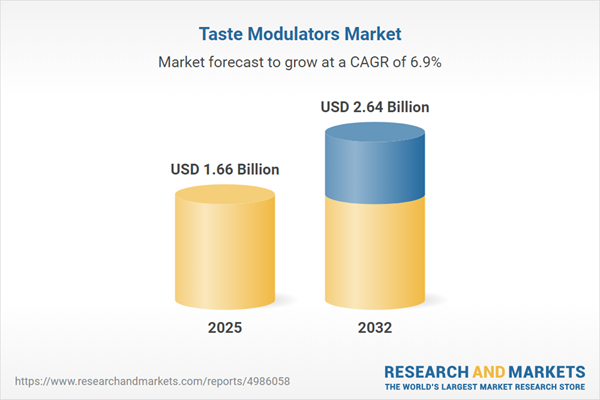Speak directly to the analyst to clarify any post sales queries you may have.
The taste modulators market is presenting unique strategic opportunities as industry leaders adapt to shifting consumer expectations and navigate multifaceted regulatory environments. Executives are pursuing innovative product development, agile supply chains, and operational excellence to meet the rising complexity in this global sector.
Market Snapshot: Taste Modulators Market Size and Growth
The global taste modulators market is advancing significantly, with size projected to move from USD 1.55 billion in 2024 to USD 1.66 billion in 2025, ultimately reaching USD 2.64 billion by 2032. This expansion, at a compound annual growth rate of 6.88%, signals the sector’s momentum fueled by biotechnological innovations and increasing demand for clean label and natural flavor solutions. Adoption is broadening across the food, beverage, and life sciences industries as companies look to differentiate through advanced flavor technologies and diversified applications.
Scope & Segmentation of the Global Taste Modulators Market
- Type: Covers flavor modulators such as enhancers and suppressors, sweetness enhancers using bulk and high-intensity ingredients, and taste maskers including bitterness blockers and off-taste suppressors.
- Technology: Includes biotechnological processes such as enzymatic reactions with free and immobilized enzymes, fermentation techniques, and traditional chemical synthesis methods.
- Form: Comprises liquid concentrates, emulsions, and powder products like coatings and granules tailored for varied processing lines.
- Application: Extends to beverage sectors (alcoholic and non-alcoholic), cosmetic formulations (notably fragrances), food including bakery, confectionery, and dairy, and pharmaceuticals where taste modulators improve formulation.
- End User: Serves food and beverage manufacturers and pharmaceutical producers seeking differentiation and regulatory compliance.
- Region: Provides comprehensive global analysis, highlighting opportunities and challenges in the Americas (with the United States, Canada, Brazil, and Mexico), Europe, Middle East & Africa (including United Kingdom, Germany, Saudi Arabia), and Asia-Pacific (China, India, Japan, and Southeast Asia).
- Leading Companies: Features Givaudan SA, International Flavors & Fragrances Inc., Symrise AG, Kerry Group plc, Cargill, Incorporated, Archer Daniels Midland Company, Tate & Lyle PLC, Ingredion Incorporated, Ajinomoto Co., Inc., and Sensient Technologies Corporation.
Key Takeaways for Senior Decision-Makers
- Natural and clean label taste modulators are rapidly gaining traction as end-users prioritize transparency and healthier product formulations.
- Biotechnological advances, especially in enzymatic and fermentation processes, enable improved flavor accuracy and enhance the sustainability of manufacturing operations.
- Strategic collaboration between ingredient suppliers, manufacturers, and research centers is driving agile innovation and supports adaptation to diverse market needs.
- Operational excellence—particularly in scaling production and ensuring quality control—is critical to meeting regulatory requirements and maintaining consistent product standards.
- Localized manufacturing strategies and regional alliances help firms navigate regulatory complexity and reinforce supply chain resilience, especially in high-growth and evolving markets.
- Tailored approaches in beverage, food, and pharmaceutical applications allow for precise targeting, supporting alignment with consumer and regulatory trends across key sectors.
Impact of United States Tariff Requirements
Forthcoming U.S. tariff policies, set for implementation in 2025, will increase duties on cross-border transactions involving taste modulators and related inputs. This policy shift is expected to elevate supply chain costs, prompting senior executives to reevaluate manufacturing footprints, pursue more regional sourcing, and build agility into logistics frameworks. Joint ventures and expanded contract manufacturing arrangements are emerging as practical strategies to ensure business continuity and maintain sector competitiveness.
Research Methodology & Data Sources
The research for this report employs a robust methodology featuring direct interviews with industry leaders and regulatory representatives, complemented by thorough secondary analysis of sector literature, patent documentation, and official regulatory records. Findings are triangulated and validated with expert panels to ensure insight relevance and segmentation accuracy.
Why This Report Matters
- Empowers senior decision-makers with actionable intelligence for responding to industry competition, changing regulations, and external trade influences.
- Delivers deep segmentation and focused technology perspectives, supporting precise benchmarking and effective planning for innovation.
- Informs R&D investment choices, partnership strategies, and sourcing decisions with insights relevant to regional dynamics and specific end-use applications.
Conclusion
Integrated, locally adaptable strategies and innovation-driven operations position market participants to capture evolving opportunities in taste modulation. This analysis supports informed decision-making amid ongoing industry transformation.
Additional Product Information:
- Purchase of this report includes 1 year online access with quarterly updates.
- This report can be updated on request. Please contact our Customer Experience team using the Ask a Question widget on our website.
Table of Contents
3. Executive Summary
4. Market Overview
7. Cumulative Impact of Artificial Intelligence 2025
List of Figures
Companies Mentioned
The key companies profiled in this Taste Modulators market report include:- Givaudan SA
- International Flavors & Fragrances Inc.
- Symrise AG
- Kerry Group plc
- Cargill, Incorporated
- Archer Daniels Midland Company
- Tate & Lyle PLC
- Ingredion Incorporated
- Ajinomoto Co., Inc.
- Sensient Technologies Corporation
Table Information
| Report Attribute | Details |
|---|---|
| No. of Pages | 199 |
| Published | October 2025 |
| Forecast Period | 2025 - 2032 |
| Estimated Market Value ( USD | $ 1.66 Billion |
| Forecasted Market Value ( USD | $ 2.64 Billion |
| Compound Annual Growth Rate | 6.8% |
| Regions Covered | Global |
| No. of Companies Mentioned | 11 |









